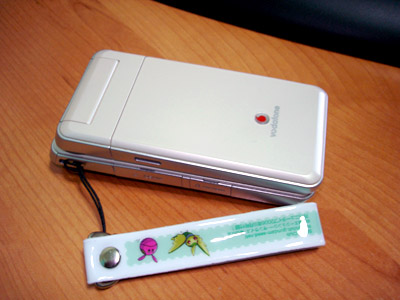
Vodafone 903SH
If you have been reading my blog since the b2 days, you would know that I own a Vodafone 903SH (the SH is for Sharp). At the time I got it, the phone was the latest 3G offering from Vodafone Japan and it’s equipped with a 3.2mp camera and all that jazz. I had to send mine to Japan for repairs some time ago and now I finally got it back today! Joy~~ I feel complete as a person once more. :P
Anyway, some people have been wondering about how to import Japanese phones for use in their own countries. Here are some things you should know first…
Japanese phones are dirt cheap. But only if you are living in Japan. Just take a look at Vodafone’s online store and you will see that most of their latest 3G offerings sell for less than 100 USD, with cameras ranging from ~2mp to 3.2mp. The most expensive phone available is 905SH, which is selling for ï¿¥22,800 (about 200 USD), but that’s because it has a built-in TV tuner…
Cheap as they may be, if you going to import the phones, prepare to pay for 4 to 6 times the list price. Here’s why…
Firstly, Japanese phones are all SIM locked to their service providers. Their telecommunication laws are pretty strict about this. As Japanese firmwares are not designed to be unlockable, unlocking generally means that you have to get someone to reflash it with a hacked firmware or an unlocked firmware for that model from a different region. Very few phones are unlockable thus they are in great demand.
Secondly, most Japanese phones do not support GSM. They just have something against GSM. Don’t even try getting Japanese 2G phones because none of them can be used outside of Japan even if you somehow trick them into accepting a foreign SIM card (assuming they have a SIM card slot in the first place!) For 3G, Japan uses the W-CDMA standard, which is compatible with the UMTS 3G network used in Singapore, Hong Kong, Australia, UK and a whole bunch of other places. Good stuff. Some 3G phones also support GSM so that Japanese who travel can roam in foreign countries.
Thirdly, the only way to get a phone in Japan is to sign up for a new line. There is no retail market for mobile phones in Japan because they are all locked to providers anyway. Breaking a contract in order to keep the phone incurs fees, paperwork and sometimes getting blacklisted by the provider.
Fourthly, there are usually at least two to three middlemen when you import a phone, perhaps more. The person in Japan who obtained the locked phone from Vodafone, the person who imported it to your country and perhaps another person who did the firmware hacking. They all want to make money off this.
Lastly, a lot of people want those phones. Consistent demand keeps prices sky-high because the supply is very limited.
So…
What do you get for all that trouble and money spent?
Well, for one thing, you get a damn COOL phone. Japanese phones all have beautiful exterior designs that make foreigners green with envy. You also get Japanese input and display support. They also come with very nice cameras and have some of the most amazingly clear and bright LCD displays ever used in mobile phones.
You can also scan and decode QR codes, which is quite useful if you often read Japanese websites and magazines. :P Here’s my URL encoded in QR code:
An example of QR code
Despite the numerous fees required, an unlocked Japanese phone is usually still cheaper than a locally-sold phone of similar capabilities (normal retail price and not contract price). Not to mention the fact that there are often no phones of similar capabilities available locally.
Unlocked Japanese phones also have very high resale values because of high demand and low supply. My 903SH actually resells for more than when I first purchased it, something which is unheard of for locally-purchased sets. This is because Japanese providers are constantly introducing new measures to prevent their phones from being exported and unlocked, thus limiting the supply.
On the flipside, you lose T9 input for English unless you flash the phone to UK or HK firmware (if available). Japanese firmwares are also laden with DRM protection for MP3 files and generally have very, very soft ringtones (which is fine for Japanese subway trains where no one talks aloud but probably not enough for less civilized environments). Hacks used to unlock the firmware may also introduce new bugs or result in unstable software behaviours. All in all, you need to make various compromises and be somewhat tech-savvy (with regards to DRM protections, video encoding and GPRS/WAP configuration) if you want to use your import phone to its fullest potential.
Generally, I notice three common reasons for getting a Japanese phone: the camera, the superior LCD screen and the Japanese input/display support. If none of those categories apply for you, you should probably avoid the trouble…
Where to start
Once you’ve decided that you want a Japanese phone, it’s time to decide which one. Not that there’s much of a choice since most Japanese phones cannot be unlocked. Forget DoCoMo (including the FOMA P900iV that Cloud used in Advent Children), forget KDDI. Only some Vodafone 3G models are unlockable.
Vodafone is your only choice. The ones by Sharp are mostly all unlockable; some of the Toshiba ones are too. Just look for the models that end with SH or T on Vodafone Japan.
902SH, 903SH and 904SH are some popular choices. BTW Sousuke used a black 902SH in Second Raid (my old 902SH pictured on the right :P).
In order to make your decision, you need to do some research. Most of the information related to import phones can only be found in online forums. The best forum for Singaporeans is the mobile phone section of Hardware Zone. And even if you’re not in Singapore, it’s still a great source of information. (Just ignore the idiots) You need to read up on the pros and cons of the various firmwares and the various models. For example, hacked Japanese firmware for 903SH is quite unstable and cannot receive MMS. Hong Kong firmware has Chinese and English T9 but loses Japanese display support. Etc etc.
Choosing the right importer is VERY important. If something goes wrong with your phone, Vodafone isn’t going to help you. You need to make sure the person you are buying from is reliable. Ebay and online retailers are generally overpriced. The best bet is to visit your local tech/mobile phone forums and look for a reputable private dealer. For Singaporeans, look for “kuro” on HWZ forums. He’s pretty much the person to go to for import phones.
The payoff
This is what I got for all my troubles…
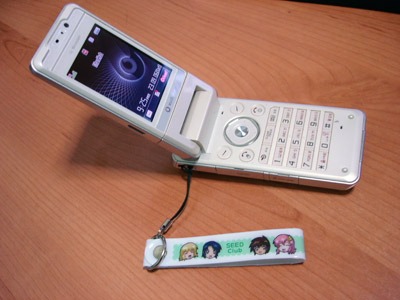
Vodafone 903SH
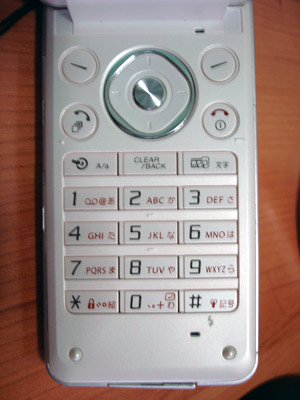
Vodafone 903SH
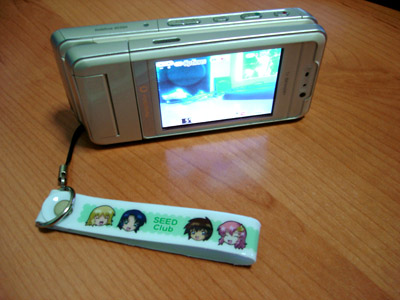
“Camera” mode
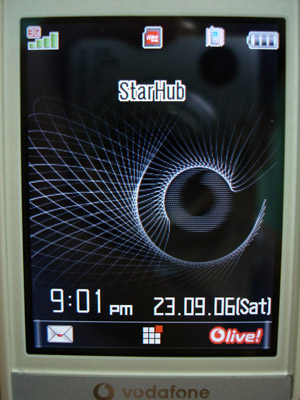
Standby screen
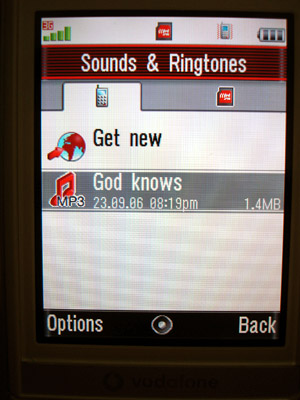
My current ringtone
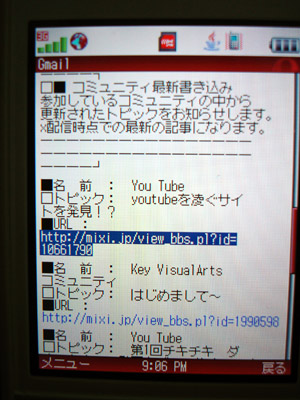
Gmail in Opera Mini
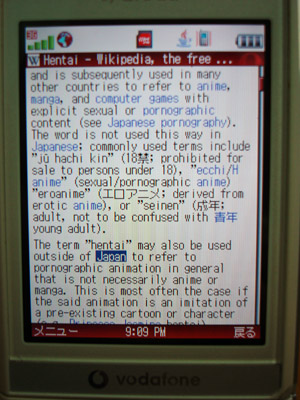
Wikipedia in Opera Mini
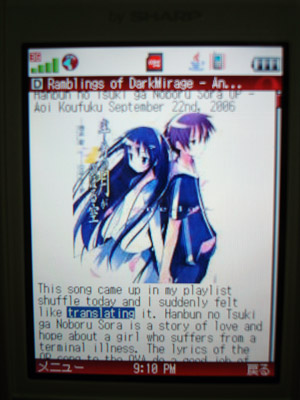
This blog in Opera Mini
Refer to my old post for picture quality. It’s pretty good for a 3.2mp phone, but certainly not as good as a 3mp digicam. :P
I am using the UK firmware now, which is actually pretty good except for the lack of Japanese input. That said, I’m planning to switch back to Japanese once a more stable version of the hacked firmware is released. After living without English T9 input for so long, I realized that I am not used to it any more… lol.

constantly i used to read smaller articles which also clear their motive,
and that is also happening with this post which I am reading now.
Here is my web page
at does url mean enter password to unlock your iphone backup file windows
unlock sim card in iphone 4 can i unlock iphone 5 on ee unlock iphone 4 to boost mobile
i cant turn on my vodafone like that …..please help me …. but it has a power
Hey there,
Want to reach new customers?
We are personally inviting you to sign up with one of the leading influencer and affiliate networks on the web.
This network finds influencers and affiliates in your niche who will promote your company on their sites and social media channels.
Benefits of our program consist of: brand name exposure for your product or service, increased credibility, and potentially more clients.
It is the best, easiest and most efficient way to increase your sales!
What do you think?
Learn more: http://bit.ly/nichevendor